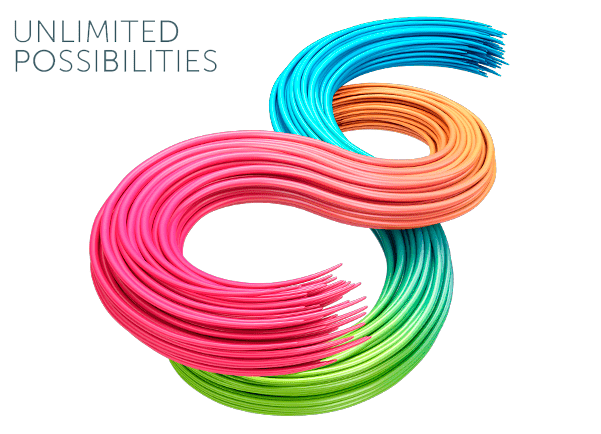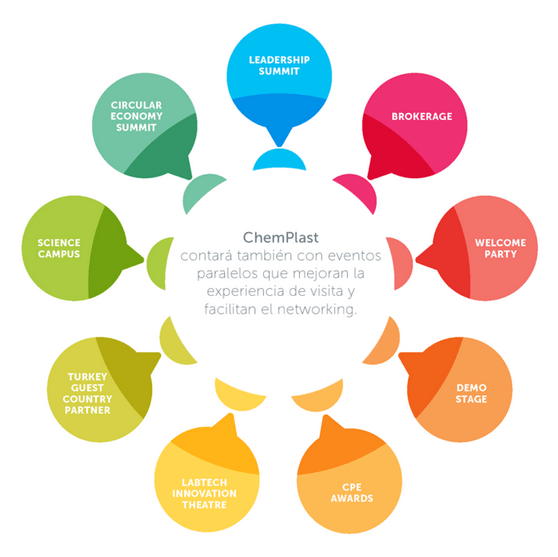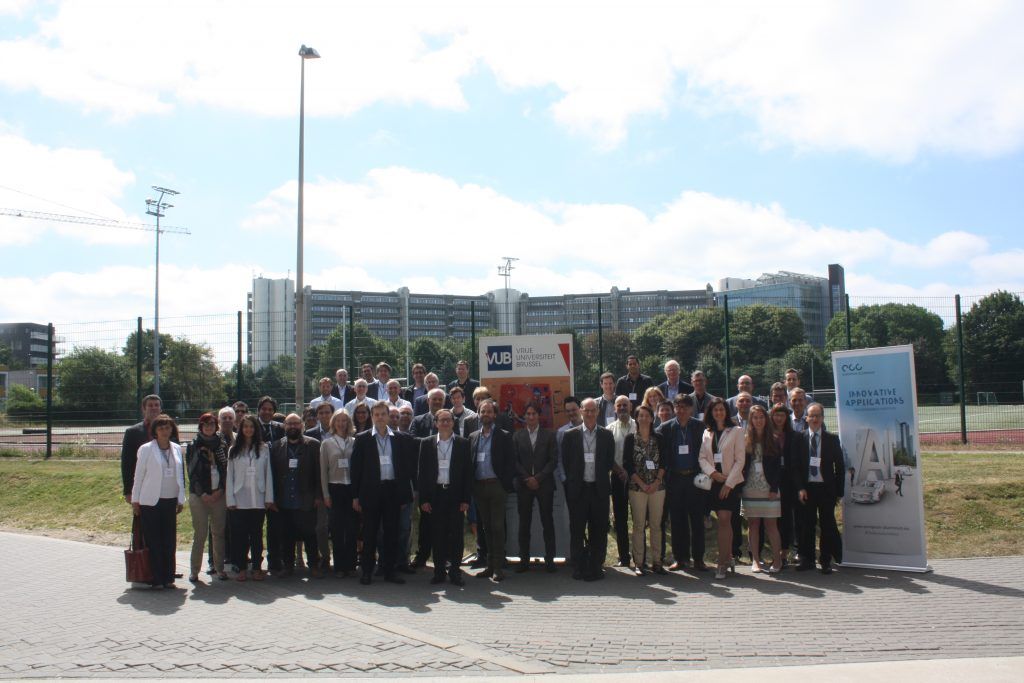by cidaut | Oct 22, 2018 | Sin categoría


ChemPlastExpo, organized by Nebext in collaboration with Ainia Centro Tecnológico, is a 3-day Congres that will take place in Madrid during the 6-8th November 2018.
CHEMPLAST is a space to discover the latest emerging technologies and the most innovative solutions for the industry 4.0 in chemical and plastics sectors, a mandatory meeting for any professional who wants to boost their factory to the maximum level of competitiveness and innovation. CIDAUT will be one of the exhibitors at CHEMPLAST, at our stand you will be able to meet our material development experts, discuss circular economy highlights, composite developments and know more about our latest innovation projects and prototypes. Meet us there and let’s discuss new collaboration opportunities!

CIDAUT will also participate actively at the European Congress of Plastics Engineering. Our colleagues Karina Núñez will be presenting “Thermoplastic pultrusion as promising recycling technology”; Manuel Herrero will be presenting his research in “bio based polyamides for industrial applications”; and Blanca Araujo will present “Opportunities and challenges for structural thermoplastic composites”. Blanca will also moderate one of the parallel sessions: “Plastic innovations applied to the automotive and aeronautics industries”.
Feel free to get in touch with us at newsletter@cidaut.es to arrange meetings with our experts, and do not hesitate to visit our stand!
by cidaut | Jul 27, 2018 | Sin categoría

Last June 20th European Aluminium held a workshop for its members in which CIDAUT was invited to take part. Around 60 industry and research experts attended European Aluminium’s Innovation Hub workshop, jointly organised with Professor Herman Terryn from SURF group at the VUB university in Brussels. The agenda covered general presentations from SPIRE (sustainable process industry) and “Factories of the Future” public-private partnerships focusing on the current and upcoming European funding Programmes. Later parallel sessions on Circular Economy and Digitalization took place. The workshop aimed at encouraging collaboration with aluminium industry and to initiate project ideas, potentially under the Horizon 2020 framework programme.
CIDAUT presented in the Circular Economy sessions its currently patent pending technology on molten aluminium purification. CIDAUT developed a technology able to remove impurities from molten aluminium, and validated it with iron removal. Starting with samples contaminated with different levels of iron, ranging from 0.8% to 3.5%, reductions up to 0.5% were achieved at the lab for all the different samples and contamination values. This technology was upscaled to a pre industrial device in which a 40% of Fe removal has been measured.
This technology is framed in one of the pillars driving CIDAUT’s innovation, the Circular Economy. In this field, not only aluminium is recycled, as presented in this event. CIDAUT also coordinates the Remaghic project in which magnesium and rare earths are recovered from different streams to create new alloys. The efforts also reach the plastics field, in which many different projects have covered the treatment of unused plastic fractions to find new market applications and promote the development of new sustainable materials.
Visit European Aluminium to know more about the Innovation Hub, here.
by cidaut | Jun 20, 2017 | Sin categoría
Boecillo (Valladolid, Spain), June 13 2017
CIDAUT Foundation, in conjunction with the chemical giant and global automotive supplier BASF, presented on June 13 their last capabilities and solutions to meet the new challenges posed by new mobility systems. The solutions shown were plentiful and opened a wide variety of alternatives.
The Workshop, celebrated at CIDAUT’s premises in Boecillo Technological Park (Valladolid, Spain), was attended by more than 100 people, mainly technical product managers and technicians and professionals from the main companies of Castilla y Leon´s automotive sector. In this way, car manufacturers as Renault España or Nissan Motor Manufacturing and automotive suppliers as Grupo Antolin, Faurecia, Flex-N-Gate, Gestamp, IAC Group, Reiner, Reydel Automotive, ZF-TRW, Repsol, Casple, Treves, Safran engineering, Vulcanizados Álvarez, Grupo Ubiplast, Grudem, etc. were fully represented.

The technical workshop was chaired by the president of CIDAUT Foundation, Mr. José Oliveri Gandarillas, and by the BASF Commercial Manager Mrs. Katarzyna Byczkowska. During the workshop, representatives from BASF´s QEHS Product Stewardship Division, Performance Materials – Engineering Plastics Division, Performance Materials – Polyurethane Systems Division, Performance Materials – TPU Division, Dispersions Division, and Coatings Division explained about: “Sustainability applied to automotive product”; “Electronic and electrical systems; Ultramid® Advanced N plastics for sophisticated components and applications”, “Polyurethane in Automotive sector: acoustic advanced applications, and new used of Cellasto® foams”; “Thermoplastic Polyurethanes (TPU) in automotive sector”; “New development and applications of BASF´s Acrodur® for composite in automotive sectors”, and “Presentation of the new BASF’s iGloss® clearcoat technology”.
In the second block, Mr. Javier Romo, R&D Project Manager of CIDAUT Foundation, explained about the vision of this Research Centre related to new materials and processes applied to the vehicles of the future. On this concept, Javier Romo delved into several European research projects carried out by CIDAUT in collaboration with other partners (significant companies of automotive sector and other research centers). Such is the case of e-LIGHT Project (Advanced Structural Light-Weight Architectures for Electric Vehicles), URBAN-EV project (Super Light Architectures for Safe and Affordable Urban Electric Vehicles), or PLUS-MOBY Project (Premium Low weight Urban Sustainable e-MOBilitY), in which different materials are combined to achieve superior performance in terms of strength, weight, and volume utilization. Finally, Mr. Raúl García Esparza from the Spanish Center for Technological and Industrial Development (CDTI) informed about its programs to support R&D initiatives inside automotive sector. The event was closed by the assistant deputy of the national government in Valladolid Mr. Luis Antonio Gómez Iglesias.
In addition, the conference featured a wide exhibition area in which CIDAUT and BASF showed some of their solutions and products explained during the different sessions of the Workshop. In this way, more than 50 plastic solutions both automotive sector than aeronautics sector were shown. By way of example, some of the solutions exhibited were: a grille open reinforcement 2016 Ford Mustang Shelby GT350 (first to market resistant implant-welded, closed-section composite structure); innovative snow chains based in different BASF´s elastollan® product; a front bearing of VW Golf VII manufactured in PA6-GF40 (BASF´s Ultramid B®); BMW i3 seat with backrest in polyamide (PA BASF´s Ultramid®) and integral structural part for carbon body (PBT); Daimler´s rare axle transmission crossbeam manufactured in PA66-GF50; a VOLVO´s Engine Cover manufactured in PU (Polyurethane); a PSA´s injection pump cover manufactured in BASF´s Elastollan® C85A15HPM + PA6 40%GF; a VW´s door handle in different materials; a roll bars protector; a Land Rover´s, Audi´s and PSA´s shift levers manufactured in different materials,; a Ford´s steering wheel manufactured in BASF´s PU/ESA Elastofoam® I; a VW Golf VI´s central console manufactured in TPU/ESA; an AUDI´s cockpit manufactured in BASF´s PU/ESA Elastoflex®; a Citroën C4 Cactus´s rear tailgate cover manufactured in polyester-polyurethane elastomer (BASF´s Elastollan AC 55D10 HPM), etc.



One of the powerful solutions shown was a leading edge of Airbus A320 development by CIDAUT in epoxy RTM6 + satin 5 using a RTM technology in a closed mould, as well as a BASF´s concept of electric velocipede called ‘concept 1865’. This e-velocipede counts with 24 different polymer applications, such as bearingless all-plastic pedals made of “ultrason®” and puncture-proof tires made of “infinergy®” (a closed cell expanded thermoplastic polyurethane).
 BASF´s concept 1865 electric velocipede
BASF´s concept 1865 electric velocipede
It was also very interesting to display Cidaut´s innovative “hybrid IP beam concepts” for automotive sector manufactured in different materials: metal and PA30%GF using a press-on-metal technique; PP30%GF + TEPEX using an injection technology over structural thermoplastic (TEPEX); frames Airbus A400M also manufactured by CIDAUT in epoxy RTM6 + satin 5 using a RTM technology in a closed mold; aesthetic pieces of vehicle interior parts with different vegetal fiber contents (PP-PE + sisal fiber) and colours; door panel´s baguettes manufactured in PP-PE using a direct monochrome film injection process with 150 micron thickness; a fuel tank manhole cover of Airbus A-380 manufactured in Polyether ether ketone (PEEK) reinforced by carbon fiber (PEEK 30%CF). This is an external non-structural part for which the critical issues were weight, chemical resistance and fuel resistance, which represents the largest piece ever manufactured in those materials.

Some CIDAUT´ solutions (Left: leading edge of Airbus A320. Right: A380 HTP Manhole Cover); aesthetic pieces PP-PE + sisal fiber; frames Airbus A400M; A380 HTP Manhole Cover made of PEEK30%CF) were also part of the showroom.
by cidaut | Jun 20, 2017 | Sin categoría
The aim of the workshop was to provide practical information on the overall functioning of this European initiative to support transnational cooperative R&D on automotive sector (Clean Sky 2), in particular the 6th call for proposals.
Clean Sky is the largest European research programme developing innovative, cutting-edge technology aimed at reducing CO2, gas emissions and noise levels produced by aircraft. Funded by the EU’s Horizon 2020 programme, Clean Sky contributes to strengthening European aero-industry collaboration, global leadership and competitiveness. This 6th Clean Sky call for proposals is the biggest Call ever launched by Clean Sky 2: 74 topics with a funding of 68.8M€. The deadline is 21 June 2017.
In this Workshop, CIDAUT Foundation exposed its experience in Clean sky programme. Inside the aeronautics sector, CIDAUT Foundation has a long tradition working for leading companies in programmes for the development of components and structures for commercial and military airplanes, focusing on those projects that involve the introduction of new materials or processing technologies. Cidaut Foundation´s offer moves around three concepts: Development Engineering, Advanced Engineering, and Prototyping and Manufacturing.


During the workshop, CIDAUT Foundation deepened its experience in some of the most representative projects, which this technological center has carried about, both on its own and in combination with other partners. In particular, the Cidaut’s representative addressed on those projects financed under the Clean Sky programme:
- PLIT Project. Development of advanced Liquid Infusion Technology for regional wing panels structure: numerical simulation of the process and validation through an innovative test bench.
- NEMESIS Project. New trends and market survey for the end of the life of aircrafts. Eco design guideline.
- REMART Project. Recycling of metallic materials from rotocraft transmissions.
- ACID Project. Advanced composite integrated skin panel structural testing.
- Project. Development of an innovative welding process for the rapid assembly of thermoplastic brackets to thermoset-matrix composite structures.
- ACCUBLADE Project. Low cost design approach through simulations and manufacture of new mould concepts for very high tolerance composite components.
- ALMAGIC Project. Aluminium and Magnesium Alloys Green Innovative Coatings.

by cidaut | Jul 13, 2015 | Sin categoría
Progressive autonomous vehicle functions and levels have a great opportunity to create significant benefits to society and economy. Vehicles equipped with this cutting-edge technology will likely reduce crashes, energy consumption and pollution, as well as reduce costs associated with congestion.
Additionally, the integration of intelligent technology in vehicles have a great potential for providing increased mobility for certain population that today have difficulties in getting a flexible and accessible mobility in urban and interurban modalities. Fully autonomous cars could also improve land use, and create new business models based in new car sharing and travel infotainment passenger customized services.
These benefits are a fantastic pillar for Automotive OEMs and Tier1, Technology companies and technological R&D providers, as well as Governments to launch a highly involved and enthusiastic resources investment in developing within a fast rate and high quality level new technology development activities, integration and wide in-depth validation of electronic functions for qualifying cars in the track of a full autonomous vehicle.
Full target achievement will be a question of time taking into account the technology development rate in this field during last decade. Meanwhile, many challenges have still to be solved and managed from different perspectives. This is the reason why CIDAUT has reinforced his compromise with the involvement in technological advance.
CIDAUT’s vision of participation and involvement in progressive automatic pilot electronic functionalities is based in our positive background of knowledge capitalization due to our participation and contribution to international and national R&D activities and internal product, services and knowledge generation.
Main topics within CIDAUT strong background perspective related to automatic electronic functions development and integration are:
- Design, development, and data processing & analysis of FOT and Naturalistic studies for the requirements in-depth evaluation and user acceptance from a cognitive and physic perspective.
- Tests and studies in driver simulator lab
- Architecture definition and instrumentation of HW/SW for experimental vehicles.
- HMI system development fitted to driver environment and user requirements
- Mobile Apps Development integrating with high engineering content integrating connectivity and geolocalization features.
- Computational Vision: Function development of partial automation vision based sensors. RT Online Video processing and feature information extraction. Integration in experimental vehicles.
- Driver monitoring and attention management system development vision sensor and sensor data fusion based.
- Virtual predefinition of ADAS – EM actuators and vehicular dynamics integration.
- Development of ITS technologies in roadway infrastructure for all road users safety enhancement. Support measures for progressive automatic vehicles.


These practices have been put for the benefit and have been feed backed by a balanced participation in R&D projects contributing to the global state of the art in the field. As an example we have proudly participated in the following initiatives:


These contributions were consolidated within EU 6th and 7th FP, and those were projects that started the track to progressive automation of vehicles. CIDAUT participation was focused in key aspects such as: human factor and driver cognitive ergonomics, HMI systems, application and functions development and technology evaluation by means of extensive FOTs and testing in driving simulator lab.
Additionally, the participation of CIDAUT within Spanish National R&D projects can be summarized in next figure:

Thanks to these initiatives where CIDAUT has been working with the greatest involvement and enthusiastic illusion, we are proud to say that we are on the track of the future automatic pilot vehicles.
And from this point forward, we will continue increasing our efforts for moving towards the vehicle fatalities zero vision and mobility efficiency.

















